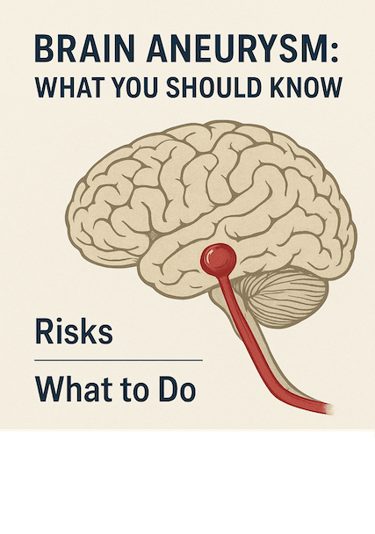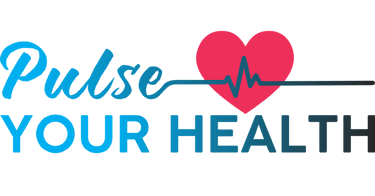Stay updated on what is trending in health. Discover tips and resources for a healthier, balanced life.
Brain Aneurysm: What It Is, Causes, Risks & What You Can Do
Learn what a brain aneurysm is, why it’s dangerous, its warning signs, treatment options, risks and how you can reduce your risk. Stay informed and stay safe.
DISEASES AND CONDITIONS
Dr. S. Ali
11/30/20256 min read


Imagine a tiny weak spot in one of the blood vessels in your brain. Over time, that weak spot puffs up like a balloon — and if it bursts, it can lead to life-threatening bleeding. That’s essentially what a brain aneurysm is — and while it sounds dramatic (because it is), understanding it could help you spot warning signs, manage risk, and know when to act fast.
What is a Brain Aneurysm?
A brain aneurysm (also called a cerebral or intracranial aneurysm) happens when an artery in the brain develops a thin, weak spot in its wall. Blood flowing through that vessel puts constant pressure on the weakened area, causing it to bulge outward like a bubble.
Most of the time, an aneurysm is unruptured (intact) and causes little or no symptoms. But if it leaks or breaks, the consequences can be very serious because bleeding occurs into or around the brain.
How Common Are They?
Here are some numbers to give perspective:
It’s estimated that about 1 in 50 people in the U.S. may have an unruptured brain aneurysm.
The annual rate of rupture is much lower — about 8 to 10 per 100,000 people.
Most aneurysms go unnoticed because they don’t cause symptoms.
These stats show that while having an aneurysm is relatively common, having one rupture is much rarer — and that’s where awareness matters.
What Causes a Brain Aneurysm?
There isn’t always a clear cause, but many factors weaken artery walls or increase pressure in them. Some of the key contributors:
High blood pressure (hypertension): Constant high pressure stresses artery walls.
Smoking: Damages blood vessels and increases rupture risk.
Genetic/connective tissue conditions: Some people are born with weaker vessel walls or inherited disorders (e.g., Ehlers-Danlos, polycystic kidney disease) that raise risk.
Artery structure and location: Aneurysms often form where arteries branch — that’s a structurally weaker point.
Age and sex: They’re more common in adults (ages 30-60) and somewhat more common in women than men.
While you can’t change your genes or anatomy, many of the other risk factors are things you can control.
Signs & Symptoms: What to Watch For
Unruptured aneurysm (before it bursts)
Unruptured brain aneurysms are often silent, meaning many people have no symptoms at all. However, if an aneurysm grows large or presses on nearby nerves or brain structures, symptoms can appear — and these depend on the aneurysm’s location.
You might notice:
Headache or pain above or behind one eye.
Vision changes, such as double vision or a drooping eyelid.
Facial numbness or tingling, often on one side.
Difficulty with balance or coordination, if the aneurysm affects the back of the brain.
Weakness or speech problems, when areas controlling movement or language are involved.
Because these warning signs can be mild or easily mistaken for other issues, many aneurysms remain undetected until they’re found incidentally on a brain scan for another reason.
Ruptured aneurysm (medical emergency)
When a brain aneurysm ruptures, it causes bleeding into the space around the brain — a subarachnoid hemorrhage (SAH). This is a medical emergency that needs immediate attention.
Symptoms often come on suddenly and severely, and may include:
A sudden, extremely severe headache — often described as “the worst headache of my life.”
Nausea and vomiting.
Neck stiffness or pain.
Blurred or double vision.
Sensitivity to light.
Seizures.
Loss of consciousness or confusion.
If someone experiences a sudden, intense headache, especially with any of these symptoms, it’s crucial to call emergency services right away. Prompt brain imaging (CT or MRI) can quickly detect bleeding and guide life-saving treatment.
Why It Matters: Complications & Outcomes
When an aneurysm ruptures, it’s no small incident. Here’s what can happen:
Bleeding raises pressure inside the skull, reduces oxygen supply to brain tissue, and can cause brain damage.
Only about half of the people who suffer a ruptured aneurysm survive. And among survivors, many are left with permanent neurological damage.
Because of the risks, early detection and treatment are key.
How Is a Brain Aneurysm Diagnosed?
If an aneurysm is suspected (or found incidentally), your doctor may use:
CT scan or MRI: To see blood vessels and detect bleeding.
Angiography (CT or MR + dye): To look closely at arteries and aneurysms.
Monitoring: If an aneurysm is small and low-risk, sometimes doctors recommend watching it rather than immediate treatment.
Importantly: If someone suddenly develops a severe, explosive headache — often described as the worst headache of their life — along with other symptoms like nausea, vision changes, or loss of consciousness, it could be a sign that an aneurysm has ruptured. In such cases, doctors need to perform brain imaging immediately to confirm what’s happening and start urgent treatment.
Treatment Options
For unruptured aneurysms
If your doctor determines the risk of rupture is high (based on size, location, your health, family history, etc.), treatment may include:
Endovascular coiling: A minimally invasive procedure where coils are inserted into the aneurysm via a catheter to promote clotting and prevent rupture.
Surgical clipping: Open-surgery approach where a tiny clip is placed at the neck of the aneurysm to stop blood flow into it.
For ruptured aneurysms (when it bursts)
This is urgent. The goals are to stop the bleeding, reduce pressure, and prevent further damage. Treatment includes:
Emergency surgery or endovascular procedures.
Intensive care, monitoring for complications (e.g., vasospasm, hydrocephalus).
Because time is brain: the quicker the treatment, the better the chance of recovery.
Reducing Your Risk & Prevention
While some factors can’t be changed (age, family history, inherited conditions), many modifiable habits help reduce risk:
Control blood pressure. High blood pressure weakens vessels.
Stop smoking. Smoking is a strong risk factor for aneurysm formation and rupture.
Avoid alcohol and drug use. Especially cocaine and similar stimulants that spike blood pressure.
Discuss family history and inherited conditions with your doctor — if your family has had aneurysms, you might need closer monitoring.
Stay aware of symptoms. If you ever get a sudden, intense headache or vision change, don’t assume it’s a migraine without checking.
Prevention doesn’t guarantee you won’t develop an aneurysm, but healthy choices significantly lower your risk.
Living With a Brain Aneurysm
If you know you have an unruptured aneurysm:
Stay in regular contact with your neurologist or vascular specialist.
Follow up with imaging as recommended.
Make lifestyle changes (blood pressure, smoking, diet, exercise).
Don’t ignore new or worsening symptoms (headaches, vision changes).
If you recover from a rupture:Rehabilitation may be needed (speech therapy, physical therapy, occupational therapy).
Emotional recovery is also key — surviving a brain bleed is a major life event.
Long-term monitoring and care are important, because recovery often continues months or years after the event.
Frequently Asked Questions About Brain Aneurysms
1. Can you live a normal life with a brain aneurysm?
Yes — many people with small, unruptured aneurysms live normal, healthy lives. Regular monitoring, blood pressure control, and avoiding smoking can reduce the risk of rupture.
2. What causes a brain aneurysm to burst?
Aneurysms can rupture when the pressure inside blood vessels increases — often due to high blood pressure, intense physical strain, or even severe emotional stress. Some ruptures happen suddenly without a clear trigger.
3. Can brain aneurysms run in families?
Yes. Having a close relative (parent, sibling, or child) with a brain aneurysm slightly increases your risk. In such cases, doctors may recommend screening with MRI or CT angiography.
4. How is a brain aneurysm diagnosed?
Most are found through imaging tests like CT scans, MRIs, or cerebral angiograms. Sometimes, they’re discovered by chance when you have a scan for another reason.
5. What’s the difference between an aneurysm and a stroke?
A brain aneurysm is a weakened bulge in a blood vessel. A stroke happens when blood flow to part of the brain is interrupted — either by a clot (ischemic stroke) or bleeding (hemorrhagic stroke). A ruptured aneurysm can cause the latter type.
6. How do doctors treat brain aneurysms?
Treatment depends on size, location, and whether it has ruptured. Options include endovascular coiling (filling the aneurysm with tiny coils to stop blood flow) or surgical clipping (placing a clip around its base). Small, unruptured aneurysms may just need regular monitoring.
7. Can a healthy lifestyle help prevent aneurysms?
Absolutely. Managing blood pressure, eating a balanced diet, avoiding smoking, exercising regularly, and limiting alcohol can all help keep blood vessels strong and lower the risk.
Key Takeaways
A brain aneurysm is a weak bulge in a brain artery wall; when it ruptures, it can cause sudden bleeding in the brain with very serious consequences.
Many people carry unruptured aneurysms that never rupture — but because rupture is unpredictable, awareness matters.
Recognizing symptoms, managing modifiable risks (like hypertension, smoking), and seeking prompt care when needed are crucial.
Treatments for aneurysms (both before and after rupture) have advanced significantly, offering good outcomes when handled early.
If you ever experience a sudden ‘thunderclap’ headache, vision changes, or neck stiffness, don’t wait — get medical attention immediately.
Sources:
· Mayo Clinic. Brain aneurysm — Symptoms & causes.
https://www.mayoclinic.org/diseases-conditions/brain-aneurysm/symptoms-causes/syc-20361483 Mayo Clinic
· MedlinePlus. Brain aneurysm.
https://medlineplus.gov/brainaneurysm.html MedlinePlus
· Brain Aneurysm Foundation. Statistics & facts.
https://www.bafound.org/statistics-and-facts/ Brain Aneurysm Foundation
· National Institute of Neurological Disorders and Stroke (NINDS). Cerebral Aneurysms.
https://www.ninds.nih.gov/health-information/disorders/cerebral-aneurysms NINDS
· Mayo Clinic. Brain aneurysm — Diagnosis & treatment.
https://www.mayoclinic.org/diseases-conditions/brain-aneurysm/diagnosis-treatment/drc-20361595
Pulse Your Health
Empowering you to achieve your health goals.
Contact
© 2025. All rights reserved.
Disclaimer: The content on this website is for informational purposes only and is not medical advice. Always seek the advice of your physician or other suitably qualified healthcare professional for diagnosis, treatment and your health related needs.
